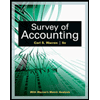
Journalize the stock investment transactions in the books of Industries S under the fair value method.
Explanation of Solution
Stock investments: Stock investments are equity securities which claim ownership in the investee company and pay dividend revenue to the investor company.
Debit and credit rules:
- Debit an increase in asset account, increase in expense account, decrease in liability account, and decrease in
stockholders’ equity accounts. - Credit decrease in asset account, increase in revenue account, increase in liability account, and increase in stockholders’ equity accounts.
1)
Prepare journal entry for the purchase of 1,000 shares of Company T at $85 per share and a brokerage of $150.
| Date | Account Titles and Explanations | Post. Ref. | Debit ($) | Credit ($) | |
| February | 24 | Investments–Company T Stock | 160,200 | ||
| Cash (1) | 160,200 | ||||
| (To record purchase of shares for cash) | |||||
Table (1)
- Investments–Company T Stock is an asset account. Since stock investments are purchased, asset value increased, and an increase in asset is debited.
- Cash is an asset account. Since cash is paid, asset account decreased, and a decrease in asset is credited.
Working Note (1):
Compute amount of cash paid to purchase Company T’s stock.
Prepare journal entry for the purchase of 2,000 shares of Company I at $40 per share and a brokerage of $100.
| Date | Account Titles and Explanations | Post. Ref. | Debit ($) | Credit ($) | |
| March | 16 | Investments–Company I Stock | 80,100 | ||
| Cash (2) | 80,100 | ||||
| (To record purchase of shares for cash) | |||||
Table (2)
- Investments–Company I Stock is an asset account. Since stock investments are purchased, asset value increased, and an increase in asset is debited.
- Cash is an asset account. Since cash is paid, asset account decreased, and a decrease in asset is credited.
Working Note (2):
Compute amount of cash paid to purchase Company I’s stock.
Prepare journal entry for sale of 500 shares of Company T at $100, with a brokerage of $50.
| Date | Account Titles and Explanations | Post. Ref. | Debit ($) | Credit ($) | |
| July | 14 | Cash (3) | 49,950 | ||
| Gain on Sale of Investments(5) | 9,900 | ||||
|
Investments–Company T Stock (4) | 40,050 | ||||
| (To record sale of shares) | |||||
Table (3)
- Cash is an asset account. Since cash is received, asset account increased, and an increase in asset is debited.
- Gain on Sale of Investments is a revenue account. Since revenues increase equity, equity value is increased, and an increase in equity is credited.
- Investments–Company T Stock is an asset account. Since stock investments are sold, asset value decreased, and a decrease in asset is credited.
Working Note (3):
Compute cash received from sale proceeds.
Working Note (4):
Compute cost of stock investment sold.
Working Note (5):
Compute realized gain (loss) on sale of stock.
Prepare journal entry for sale of 1,000 shares of Company I at $34, with a brokerage of $80.
| Date | Account Titles and Explanations | Post. Ref. | Debit ($) | Credit ($) | |
| August | 12 | Cash (6) | 33,920 | ||
| Loss on Sale of Investments (8) | 6,130 | ||||
|
Investments–Company I Stock (7) | 40,050 | ||||
| (To record sale of shares) | |||||
Table (4)
- Cash is an asset account. Since cash is received, asset account increased, and an increase in asset is debited.
- Loss on Sale of Investments is a loss or expense account. Since losses decrease equity, equity value is decreased, and a decrease in equity is debited.
- Investments–Company I Stock is an asset account. Since stock investments are sold, asset value decreased, and a decrease in asset is credited.
Working Note (6):
Compute cash received from sale proceeds.
Working Note (7):
Compute cost of stock investment sold.
Working Note (8):
Compute realized gain (loss) on sale of stock.
Prepare journal entry for the dividend received from Company T shares.
| Date | Account Titles and Explanations | Post. Ref. | Debit ($) | Credit ($) | |
| October | 31 | Cash | 450 | ||
| Dividend Revenue (9) | 450 | ||||
| (To record receipt of dividend revenue) | |||||
Table (5)
- Cash is an asset account. Since cash is received, asset account increased, and an increase in asset is debited.
- Dividend Revenue is a revenue account. Since revenues increase equity, equity value is increased, and an increase in equity is credited.
Working Note (9):
Compute amount of dividend received on Company T’s stock.
Want to see more full solutions like this?
Chapter D Solutions
FINANCIAL & MANAGERIAL ACCW/CENGAGENOWV
- How can I solve this financial accounting problem using the appropriate financial process?arrow_forwardCan you provide a detailed solution to this financial accounting problem using proper principles?arrow_forwardPlease provide the accurate answer to this general accounting problem using valid techniques.arrow_forward
- Can you help me solve this financial accounting problem with the correct methodology?arrow_forwardPlease provide the accurate answer to this financial accounting problem using appropriate methods.arrow_forwardI need assistance with this financial accounting question using appropriate principles.arrow_forward
- Can you solve this financial accounting problem using appropriate financial principles?arrow_forwardI am looking for the correct answer to this financial accounting question with appropriate explanations.arrow_forwardPlease help me solve this financial accounting problem with the correct financial process.arrow_forward
 Financial And Managerial AccountingAccountingISBN:9781337902663Author:WARREN, Carl S.Publisher:Cengage Learning,
Financial And Managerial AccountingAccountingISBN:9781337902663Author:WARREN, Carl S.Publisher:Cengage Learning, Financial AccountingAccountingISBN:9781337272124Author:Carl Warren, James M. Reeve, Jonathan DuchacPublisher:Cengage LearningPrinciples of Accounting Volume 1AccountingISBN:9781947172685Author:OpenStaxPublisher:OpenStax College
Financial AccountingAccountingISBN:9781337272124Author:Carl Warren, James M. Reeve, Jonathan DuchacPublisher:Cengage LearningPrinciples of Accounting Volume 1AccountingISBN:9781947172685Author:OpenStaxPublisher:OpenStax College Survey of Accounting (Accounting I)AccountingISBN:9781305961883Author:Carl WarrenPublisher:Cengage Learning
Survey of Accounting (Accounting I)AccountingISBN:9781305961883Author:Carl WarrenPublisher:Cengage Learning College Accounting, Chapters 1-27AccountingISBN:9781337794756Author:HEINTZ, James A.Publisher:Cengage Learning,
College Accounting, Chapters 1-27AccountingISBN:9781337794756Author:HEINTZ, James A.Publisher:Cengage Learning, Intermediate Accounting: Reporting And AnalysisAccountingISBN:9781337788281Author:James M. Wahlen, Jefferson P. Jones, Donald PagachPublisher:Cengage Learning
Intermediate Accounting: Reporting And AnalysisAccountingISBN:9781337788281Author:James M. Wahlen, Jefferson P. Jones, Donald PagachPublisher:Cengage Learning





